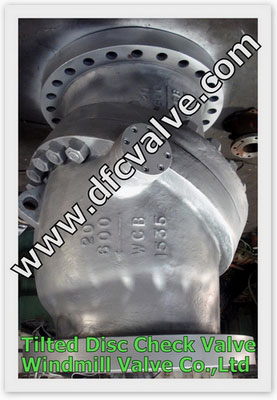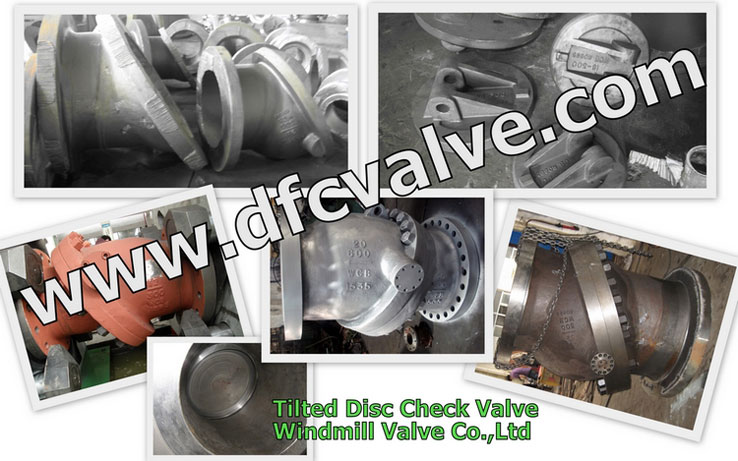Tilted Disc Check Valve
 | Applicable standards: Design description:
|

Using WINDMILL own technology to improve the mould.
The Tilted Disc Check Valve is available as a basic valve or with optional bottom mounted oil dashpot and top mounted oil dashpot in sizes 2inch- 48inch. The Tilted Disc is offered in 150LBS, 300LBS and 600LBS ANSI Classes for pressures up to 400 psig. This high performance valve provides energy efficient cost savings over the life of the valve through its hydrodynamically designed disc, 40% greater than pipe flow area and streamlined body. The Tilted Disc provides the lowest headloss of any check valve produced today.
Tilting Disc Check Valves consist of a cylindrical housing, with a pivoted circular disc. The pivots are located just above the center of the disc, and offset from the plane of the body seat. This design gives a bell-crank action to the disc. The seat is of circular bevel type and the disc drops in or out of contact without rubbing or sliding.
Tilted Disc Check Valve Features
Slamming of check valves is the result of failure of the valve disc to reach its closed position before the fluid flow reversal. Tilting disc check valves have to close rapidly since the disc has a shorter distance to travel and therefore arrives at the seat faster...minimizing a slam.
Tilting disc check valves are used to prevent reversal of flow in horizontal or vertical pipe lines. In vertical lines, or for any angle from horizontal to vertical, they can be used for upward flow only.
Tilting check valves are automatically actuated. They are opened by velocity pressure, and closed by gravity. Seating load and tightness is dependent on back pressure. The disc and moving parts may constantly move if the velocity pressure is not sufficient to hold the valve in a wide open and stable position. Premature wear and noisy operation or vibration of the moving parts can be avoided by selecting the size of check valve on the basis of flow conditions. The minimum velocity required to hold a tilting disc check valve wide open and stable can be determined by the formula:
v = 80
The value for v is equal to flow in feet per second and  is the specific volume of fluid in cubic feet per pound. Sizing swing check valves on this basis may often result in the use of valves that are smaller than the pipe in which they are used, necessitating the use of reducers for installation. The pressure drop will be no greater than that of the larger valve that is only partially open, and valve life will be greatly extended. The added bonus, of course, is the lower cost of the smaller valve.
is the specific volume of fluid in cubic feet per pound. Sizing swing check valves on this basis may often result in the use of valves that are smaller than the pipe in which they are used, necessitating the use of reducers for installation. The pressure drop will be no greater than that of the larger valve that is only partially open, and valve life will be greatly extended. The added bonus, of course, is the lower cost of the smaller valve.
Size: 2” to 42”
Pressure: ANSI Class150LB to 2500LBS
Material: Carbon Steel, Forged Steel, Stainless Steel, Duplex, Super Duplex Steel. And so on
Ends: Raise Flange, RF, RTJ, Butt Weld
Standard body design configurations
The seat, disc and pivot pins are combined into one subassembly secured to the inlet side of the body with a locking ring in sizes 3" and smaller. This construction avoids the need for extending the pivot pins through the valve body.
The seat formed on the end of the inlet body section by cobalt base alloy hard facing deposit in sizes 4" and larger. The pivot pins supporting the disc are inserted through capped and gasketed bearing bosses in the outlet section of the body.


